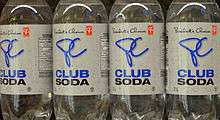Club soda
Club soda is a manufactured form of unflavored carbonated water, commonly used as a drink mixer. Potassium bicarbonate, potassium sulfate, potassium citrate, or sodium citrate is artificially added to replicate constituents commonly found in natural mineral waters.[1] Seltzer water is a similar manufactured carbonated water, but lacks added mineral content.[2]

History
English chemist Joseph Priestley discovered an artificial method for producing carbonated water, described in a pamphlet called "Directions for Impregnating Water with Fixed Air," published in 1772. The pamphlet explained the process of dripping sulfuric acid onto chalk, which produced carbon dioxide CO2 which was captured in a bowl of agitated water. Priestley thought such carbonated water was a cure for scurvy and proposed the process to Captain James Cook to prevent scurvy during his second voyage to the South Seas. Priestley never realized the commercial potential of his product, though he did refer to it as his "happiest discovery."[3]
In 1783, Johann Jacob Schweppe, a jeweler and amateur scientist of Geneva, began the commercial production of carbonated mineral water by dissolving the CO2 under pressure.[4] In 1807, Benjamin Silliman, a Yale chemistry professor, began producing carbonated water under pressure and selling it in New Haven, Connecticut. In the 1830s, Anyos Jedlik of Hungary opened a large-scale carbonated water factory. The original trademarked club soda was made by Cantrell & Cochrane of Dublin, Ireland in 1877. The 'club' refers to the Kildare Street Club in Dublin who commissioned them to produce it.[5]
As stain remover
The popular belief that carbonated water is a good remover of clothing stains, particularly those of red wine, is based on hearsay and anecdotal evidence. The dissolved gas in water acts as a temporary surfactant. There is no underlying chemical reason why carbonated water would be superior to plain water in stain removal.[6]
See also
References
- Funston, Lindsay (April 27, 2018). "What Is Seltzer - Is Seltzer Bad For You". Delish. Retrieved May 27, 2018.
- Julie R. Thomson (31 October 2014). "The Difference Between Club Soda, Seltzer And Tonic Water". HuffPost.
- Johnson, Steven. The Invention of Air.
- Simmons, David A. (1983). Schweppes The First 200 Years. Washington D.C.: Acropolis Books. p. 13. ISBN 0 87491 536 8.
- "Origin of the Words Seltzer and Club Soda for Soda Water". culinarylore.com. September 28, 2012.
- Wishnok, Pete. "How does club soda remove red wine stains?". Scientific American. Retrieved 15 April 2016.
| Wikimedia Commons has media related to Club soda. |